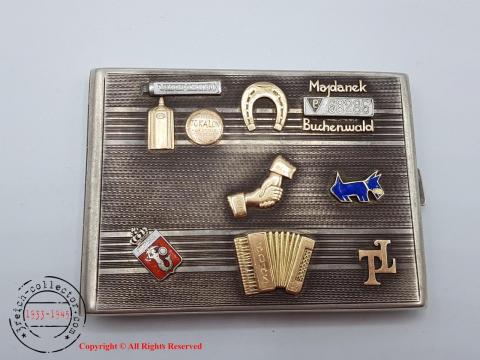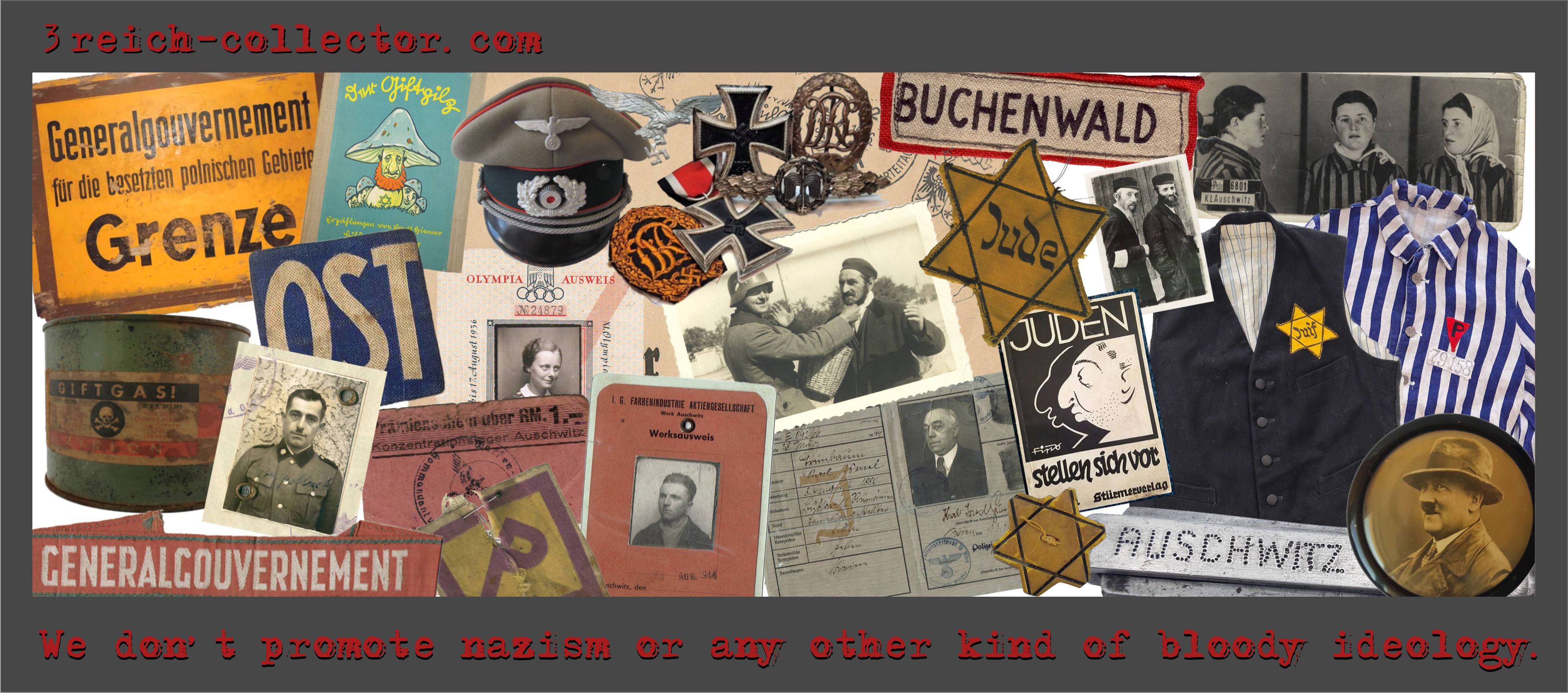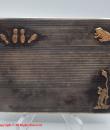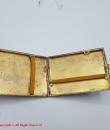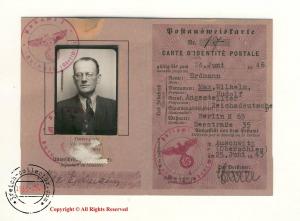Awesome one of a kind item! Gorgeous handcrafted cigarette case, souvenir of the Polish Holocaust survivor Jehuda Mirel! Made from gold, silver and enamel!
| Price: | $2,300.00 |
Awesome one of a kind item! Gorgeous handcrafted cigarette case, souvenir of the Polish Holocaust survivor Jehuda Mirel! Made from gold, silver and enamel!
Silver Art-Deco cigarette case reflecting the wealth of experiences of the Polish Jewish Holocaust victim, belonging to Ignacy Jehuda Mirel. Jehuda, born in Warsaw in 1901, was a prosperous entrepreneur in Warsaw until the start of World War II. The war turned out to be the end of Jehuda's golden years, as a Polish Jew he was sent to the Warsaw Ghetto, where despite terrible conditions he manages to persevere in the Ghetto Uprising. After miraculously avoiding death after the fall of the Ghetto Uprising, he goes to four concentration camps. His personal cigarette case portrays both the fascinating life of Mirel as an individual, his friendly and terrifying war experiences, encourages a broader discussion of Polish-Jewish heritage and is a unique mobile artifact that brings us closer to life during the Holocaust. A rectangular cigarette case made in 800 Sterling silver decorated with a total of thirteen studs, ten on the front and three on the back. The studs made with the utmost care from precious materials such as gold, silver and enamel, are nailed to the surface of the cigarette case decorated with a linear Art Deco engraving, emphasizing the beauty and the highest quality of craftsmanship characteristic of this period. Pins reflect Jehuda's character, the variety of his experiences and experiences, and apply to all light and dark experiences. From symbols of friendship and happiness, through scowls and erotic themes to a stay in a concentration camp.
The most moving, however, is the stick in the upper right corner, depicting the worst days of Jehuda. Pins depict the names of German death camps - Majdanek and Buchenwald - and number 68286, number of Mirel Jehuda from the Buchenwald Concentration Camp. Before his stay in the Mirel camps in the Warsaw Ghetto, until his fall during the uprising. He was hiding in a bunker at 62 Leszno Street until he was discovered by the Germans. His account kept at the Jewish Historical Institute (files number 301/1242) shows a terrifying experience "At the end of April 1942 the Warsaw bunker Leszno 62 in which I was sitting together with the family was discovered. They ordered us to leave, threw some gas bombs. (...) In this uprising we took share that at night we served water to bunkers where this water was not."
After being discovered in the bunker at 62 Leszno Street, he avoided death like many Jehuda and was taken with his family from the famous Umschlagplatz to KL Majdanek. "We were dressed in clogs, we were taken by several thousand people from Warsaw to the so-called" Plac Węglowy "where we were kept without eating and drinking 3 days and a night under the open sky. People were drinking mud. (...) Women with children were kept (...) separated in barracks. Two weeks later all women with children in open cars were sent to the gas chamber. Jehuda Ignacy Mirel was in four camps, starting from Majdanek, where about 80,000 enslaved prisoners lost their lives as a result of innocent work, hunger and illness. In July 1943, he was transferred to the Hugo Schneider Aktiengesellschaft Metallwarenfabrik Metallwarenfabrik ammunition factory in Skarżysko Kamienna. In terrible conditions and around 12-14 hours of work, he made picnic missiles there until August 1944, when the camp was transported due to the approaching front. After a short stay at the Buchenwald Concentration Camp, Jehuda was transported to HASAG Schlieben as one of the earliest places of the Jewish executions. Hugo Schneider Aktiengesellschaft Metallwarenfabrik Schlieben, known as the Schlieben-Berg Concentration Camp, produced Panzerfausts for the German Army. The average life expectancy of employees in this factory was 2 months.
"The most difficult work was done by Jews; there were 6,000 Jews . The SS were watching over us at work.. We worked 14 hours a day. (...) We were there to invade the Russians. They deported us 2,400 Jews. Put us for 14 days in wagons without food and threw us to Theresienstadt. Hire was Jewish only. " Ghetto in Theresienstadt was the last place of residence for Jehuda. Here he survived until the liberation by the Red Army on May 8, 1945. "After liberation, they went to Prague and then to Poland, where I didn't find any family members." Jehuda Ignacy Mirel was one of the few Polish Jews to survive the Second World War and the Holocaust
The reverse shows three studs, modest in number, but rich in content. In the upper left corner, a co-living pair in a missionary position was depicted, modestly symbolized by two pairs of shoes; for women and men, opposite the frog, to this day symbolizing luck in money (metal used as an amulet and worn in the wallet like a Tusk fish or a Chinese coin). In the lower right corner a street drunk holding a lamp. The message on the back of the cigarette case seems humorous and direct, symbolizes sex, alcohol and money, Jehuda's happy and colorful life.
The cigarette case, Mirel's personal accessory, reflects an attempt to reconcile with his tragic experiences, and also reflects the anonymous fate of millions of nameless Polish Jews persecuted during World War II. This unique object constitutes proof and testimony of those difficult to forget.
This case was made in Poland, circa 1931-1945 using silver, and all gold and enamel was used after war. It measures 10.6 cm x 7.6 cm x 1.2 cm.
Overall condition of this unique jewel is very good.
We find also in German archives few documents after him , copy below .
